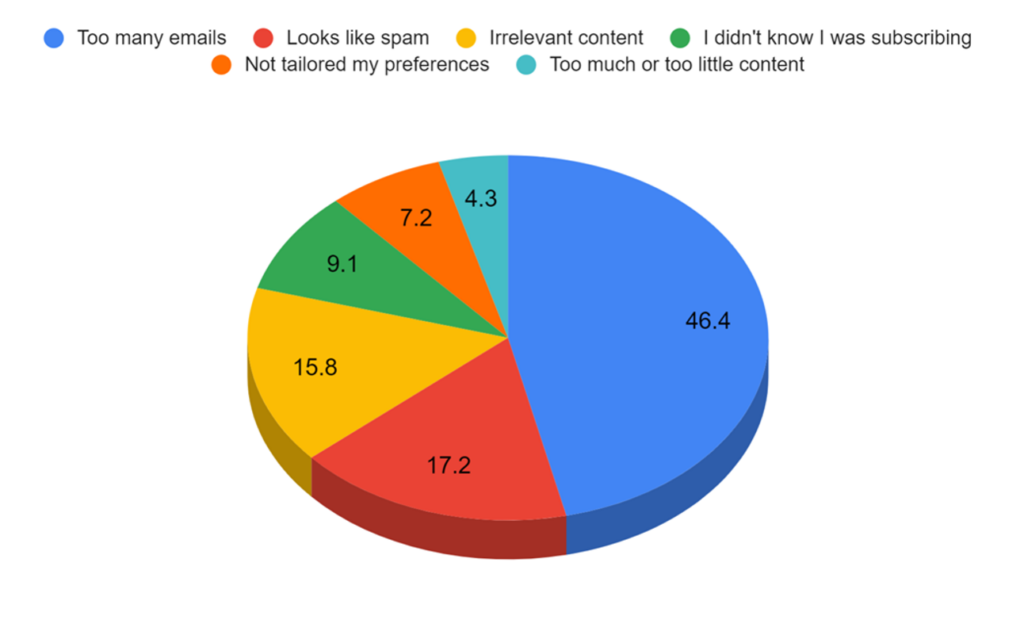- Home
- Statistics and Analytics
- Why Is My Unsubscribe Rate So ...

A high unsubscribe rate is a common and unpleasant challenge that a lot of marketers face.
So, why do people unsubscribe? Here are the top three reasons:
- Getting too many emails
- Emails feeling spammy
- Emails contain content irrelevant to users
If your unsubscribe rate is climbing, keep on reading to find out how to address the reasons above and get your subscribers back.
What Is an Unsubscribe Rate?
Before we get into how to solve the problem, let’s define it. What is the unsubscribe rate and how do we calculate it?
The unsubscribe rate is a metric that measures the percentage of recipients who opt out of your mailing list after receiving an email.
This rate is calculated by dividing the number of unsubscribes by the total number of emails delivered, then multiplying by 100 to get a percentage.
For instance, if you send out 1,000 emails and 10 recipients unsubscribe, your unsubscribe rate would be 1%.
Industry standards for unsubscribe rates vary, typically ranging from 0.2% to 0.5%. A rate higher than this benchmark suggests a need to reevaluate and adjust your email marketing strategy.
To run an effective email marketing campaign, you will need to look into how to calculate your unsubscribe rate and compare it with the average across your niche.
Let’s explore!
How to Calculate an Unsubscribe Rate
To calculate the unsubscribe rate, you can use this simple formula:

To break it down:
- Number of unsubscribes: This is the total number of people who clicked on the unsubscribe link in your email.
- Number of emails delivered: This is the total number of emails sent minus the number of bounces (emails that weren’t successfully delivered).
For example, if you sent out 10,000 emails and 50 recipients unsubscribed, your unsubscribe rate would be:

Average Unsubscribe Rate
As we’ve mentioned above, a general benchmark for the unsubscribe rate is anywhere from 0.2% to 0.5% – and it varies substantially across different industries.
Key factors that come into play here are the industry sector, the nature of the email content (promotional, informational, etc.), and how engaged the subscriber list is.
For example, industries with highly engaged audiences may experience lower unsubscribe rates, while sectors where emails are more promotional might see higher rates.
What Is a Good Unsubscribe Rate?
A “good” unsubscribe rate is one that falls below the average for your specific industry.
Generally, an unsubscribe rate of less than 0.5% is considered acceptable across many industries.
With that said, it’s never a bad idea to keep an eye on unsubscribe rates (even if they are below industry averages) and keep your readers engaged.
But remember: some level of unsubscribes is normal and even healthy for an email list. When uninterested people unsubscribe from your emails, you are left with those who genuinely engage with your content.
A very low or non-existent unsubscribe rate might actually indicate that your emails are not reaching the inbox. Or, they may hint you are not refreshing your list enough with new and engaged subscribers.
Make sure to review and adjust your email strategy regularly based on unsubscribe rates and other key performance indicators.
Why Is My Unsubscribe Rate So High? Common Reasons
Several factors can contribute to high unsubscribe rates. Understanding these reasons is the first step to keeping subscribers.

1. Email frequency: Too much of a good thing?
A common problem for many email subscribers is the overwhelming number of emails they receive. An excess can quickly lead to subscriber fatigue. This will prompt your readers to unsubscribe from what they see as too much communication.
Conversely, too few emails can disconnect subscribers from your brand. With time, they may even forget why they subscribed in the first place.
The key lies in striking a delicate balance that keeps subscribers informed and engaged without overwhelming them.
2. The critical role of personalization
We say this a lot in this blog – email personalization goes way beyond simply greeting your subscribers by name.
Today’s subscribers expect content that matches what they are interested in. If you don’t personalize and rely on generic, one-size-fits-all messaging, you may quickly lose subscriber interest.
3. The impact of content quality
Subscribers seek value from the emails they receive. They are looking for insightful information, entertainment, or exclusive offers.
Content that misses the mark — with relevance, dullness or simply a lack of clear direction — will eventually disengage your readers.
Common pitfalls include a weak call to action, content that does not match subscriber interests, or promotional material that overshadows useful content.
4. Segmentation: A targeted approach
Segmentation is what will allow you to better tailor your messaging for specific groups within your audience. Email lists are often segmented based on factors like demographics, purchase history, and engagement levels.
If you decide against segmentation, you are facing the risk of being seen as completely irrelevant by a portion of your audience — and unsubscriptions will most likely follow.
5. Navigating technical troubles
Technical issues can be very frustrating for subscribers. They can also affect the perception of your brand.
Some of the common tech problems to watch for are emails that fail to render properly across different devices, broken links, or non-loading images.
6. Adapting to changing preferences
It’s important to remember that what subscribers are interested in tends to change over time. This may lead to a mismatch between what your emails offer and what your subscribers seek.
Do your best to recognize and adapt to these changes to keep up a relevant and effective email strategy.
Strategies to Reduce Unsubscribe Rates
- Finding the right frequency
The first thing to look into is the optimal frequency for sending emails. One effective strategy here is to take this to subscribers themselves and let them set their preferred frequency through a preference center.
This will not only help you avoid unsubscriptions due to email overload but also empower subscribers to set their own rules.
- Deepening personalization
To personalize more effectively, leverage data analytics and gain valuable insights into subscriber behaviors and preferences. Use this information to tailor email content, ensuring that it speaks directly to the interests and needs of each subscriber.
Advanced personalization techniques can include dynamic content that changes based on the subscriber’s past interactions with your brand.
- Elevating content quality
Focus on making content that is both engaging and valuable to your subscribers. Some ideas are educational articles, insider insights, exclusive offers, or compelling stories that resonate with your audience’s interests.
Regularly review and refresh your content strategy to ensure it aligns with subscriber expectations and industry trends.
- Enhancing segmentation
Improve segmentation by continuously refining your audience data. Use behavioral data, purchase history, and subscriber feedback to segment your list more effectively.
This targeted approach allows for more personalized and relevant email campaigns, significantly improving engagement rates.
- Addressing technical issues
Conduct regular technical reviews of your email templates to ensure they are optimized for all devices and email clients. Address any issues promptly to avoid subscriber frustration. Utilizing responsive design and testing emails across different platforms can help prevent technical glitches that lead to unsubscribes.
- Facilitating subscription adjustments
Make it easy for subscribers to adjust their email preferences. This can include options to change the frequency of emails, select the types of content they wish to receive, or take a temporary break from emails.
To Sum Up
High unsubscribe rates can really hinder your email marketing success. To tackle this, you first need to understand why people unsubscribe and apply effective strategies to boost engagement and reduce drop-offs. The key is to nurture relationships with subscribers by consistently delivering valuable, relevant content that resonates with their needs.



